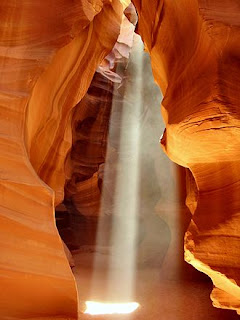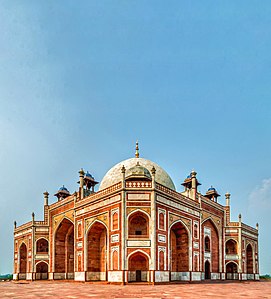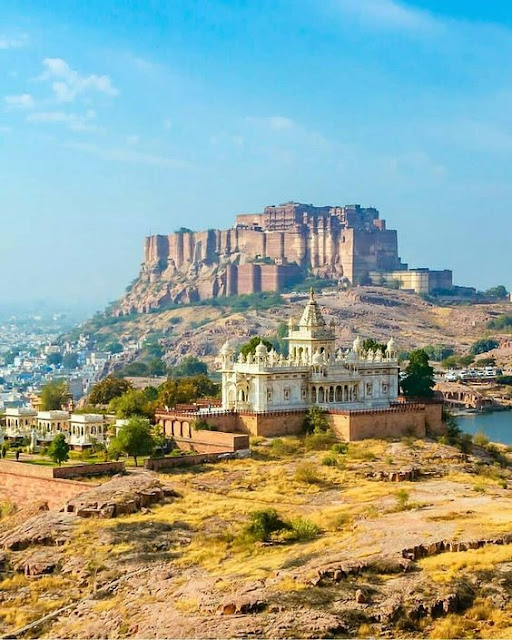Antelope Canyon
Antelope Canyon
Antelope Canyon is a slot canyon in the American Southwest. It is on Navajo land east of Page, Arizona. Antelope Canyon includes two separate, scenic slot canyon sections, referred to individually as "Upper Antelope Canyon" or "The Crack"; and "Lower Antelope Canyon" or "The Corkscrew".
The Navajo name for Upper Antelope Canyon is Tsé bighánílíní, which means 'the place where water runs through rocks'. Lower Antelope Canyon is Hazdistazí (called "Hasdestwazi" by the Navajo Parks and Recreation Department), or 'spiral rock arches'. Both are in the LeChee Chapter of the Navajo Nation. The canyons are accessible by guided tour only.
Geology
Antelope Canyon was formed by the erosion of Navajo Sandstone, primarily due to flash flooding and secondarily due to other sub-aerial processes. Rainwater, especially during monsoon season, runs into the extensive basin above the slot canyon sections, picking up speed and sand as it rushes into the narrow passageways. Over time the passageways eroded away, making the corridors deeper and smoothing hard edges in such a way as to form characteristic "flowing" shapes in the rock.
Flooding in the canyon still occurs. A flood occurred on October 30, 2006, that lasted 36 hours and caused the Tribal Park Authorities to close Lower Antelope Canyon for five months.
Tourism and photography
Antelope Canyon is a popular location for photographers and sightseers and a source of tourism business for the Navajo Nation. It has been accessible by tour only since 1997 when the Navajo Tribe made it a Navajo Tribal Park. All visits are through one of several licensed tour operators. It is not possible to visit the Canyon independently.
Photography within the canyon is difficult due to the wide range exposure range (often 10 EV or more) made by light reflecting off the canyon walls.
Inside the Lower Antelope Canyon
Inside of the Upper Antelope Canyon
Upper Antelope Canyon
Upper Antelope Canyon is called Tsé bighánílíní, 'the place where water runs through rocks' by the Navajo. It is the most frequently visited by tourists for two reasons. First, its entrance and entire length are at ground level, requiring no climbing. Second, beams or shafts of direct sunlight radiating down from openings at the top of the canyon are much more common in Upper than in Lower. Beams occur most often in the summer months, as they require the sun to be high in the sky. Winter colors are more muted. Summer months provide two types of lighting. Light beams start to peek into the canyon March 20 and disappear October 7 each year.
The "Lion's Head" rock formation inside Upper Antelope Canyon
Famed formation of Heart shape in the Upper Antelope Canyon
Lower Antelope Canyon
Inside of Lower Antelope Canyon
Stairs leading out of Lower Antelope Canyon
Lower Antelope Canyon, is called Hazdistazí, or 'spiral rock arches' by the Navajo, is located several miles from Upper Antelope Canyon. Before the installation of metal stairways, visiting the canyon required climbing along with pre-installed ladders in certain areas.
Even following the installation of stairways, it is a more difficult hike than Upper Antelope. It is longer, narrower in spots, and even footing is not available in all areas. Five flights of stairs of varying step widths are currently available to aid in descent and ascent. In the end, the climb out requires flights of stairs. Additionally, visitors should be aware of sand which consistently falls from the above crack as it can make the stairs particularly slippery.
Despite these limitations, Lower Antelope Canyon draws a considerable number of photographers, though casual sightseers are much less common there than in the upper canyon. Specific photographer-only tours are available for booking around midday when the beam of light is at its peak. Photographers are required to bring a tripod to participate.
The lower canyon is in the shape of a "V" and shallower than the Upper Antelope. Lighting is better in the early hours and late morning.
Flash flood danger
Inside Lower Antelope Canyon
Antelope Canyon is visited exclusively through guided tours, in part because rains during monsoon season can quickly flood the canyon. Rain does not have to fall on or near the Antelope Canyon slots for flash floods to whip through, as rain falling dozens of miles away upstream of the canyons can funnel into them with little prior notice.
On August 12, 1997, eleven tourists, including seven from France, one from the United Kingdom, one from Sweden and two from the United States, were killed in Lower Antelope Canyon by a flash flood. Very little rain fell at the site that day, but an earlier thunderstorm had dumped a large amount of water into the canyon basin, 7 miles (11 km) upstream. The lone survivor of the flood was tour guide Francisco "Pancho" Quintana, who had prior swift-water training. At the time, the ladder system consisted of amateur-built wood ladders that were swept away by the flash flood. Today, ladder systems have been bolted in place, and deployable cargo nets are installed at the top of the canyon. At the fee booth, an NOAA Weather Radio from the National Weather Service and an alarm horn are stationed.
Despite improved warning and safety systems, the risks of injuries from flash floods still exist. On July 30, 2010, several tourists were stranded on a ledge when two flash floods occurred at Upper Antelope Canyon. Some of them were rescued and some had to wait for the floodwaters to recede. There were reports that a woman and her nine-year-old son were injured as they were washed away downstream, but no fatalities were reported.
Access
The road to Upper Antelope Canyon is gated by the Navajo Nation and entry is restricted to guided tours led by authorized tour guides.






Comments